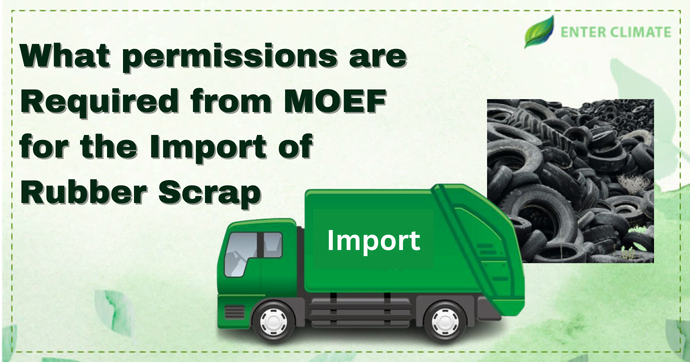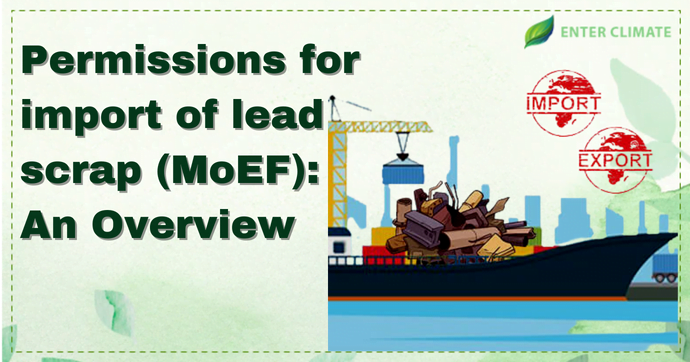What permissions are required from MOEF for the import of rubber Scrap?
 19 Oct, 2022
19 Oct, 2022 
Rubber scrap is parings, waste and scrap of rubber (other than hard rubber), along with granules and powders obtained accordingly. It is usually obtained from automotive industries and truck’s old tyres. Apart from this, there is a provision for the import of rubber scrap in India. The reason is it is often used to make new tyres. In addition, the scrap rubber is used as agriculture hoses, asphalt roadbeds, construction materials, for making basketball courts & new shoes, truck bed liners, used as artificial reefs and carbon sources etc.
Benefits of recycling rubber scrap imported in India
Rubber scrap imported in India is recycled. During recycling, steel and tire cord are detached, leaving rubber with a granular consistency. Recycling rubber scrap makes it a versatile material used in many industries and for various purposes.
Advantages of rubber scrap import in India
- Can be recycled
- An excellent alternative to coal or coke in steel manufacturing
- Can be transformed into beneficial new products
- Finds many usages in various sectors
- Prevents environment risks
Market overview of the rubber scrap import in India
Rubber scrap import in India takes place majorly from countries such as UAE (4.63 USD Million), UK (8.87 USD Million) and USA (3.81 USD Million). India imported rubber scrap worth 42.68 USD Million in 2018. The avg. market price of Rubber Scrap in India is Rs 10/ Kilogram(s).
According to the reports, the top three rubber scrap import markets are India, Vietnam and Brazil. India is the largest importer of rubber scrap and accounts for 11,546 shipments. Vietnam follows our country with 6,843 and Brazil with 1,636 shipments.
Nodal authority for granting permission for import of rubber scrap in India
Getting (the Ministry of Environment, Forest and Climate Change)MoEF permission to import rubber scrap in India is mandatory. The importers must obtain permission before importing the items. The Ministry of Environment, Forests & Climate Change is the regulatory body granting permission to export and import hazardous waste, including rubber scrap. India has stipulated strict rules and regulations for importing rubber scrap. These are to be followed by the importers to foray into the industry. Once they complete all the formalities, the exporters and importers will be allowed to import rubber scrap.
How to facilitate the import of hazardous waste, including rubber scrap, in India?
It is pretty evident that the environment and even human beings get affected by the continuous usage of hazardous items. Thus, it becomes essential that waste, including rubber scrap imported in India, be disposed of properly. Keeping all this in mind, it must be understood that businesses anticipating entering into this sector must comply with all the legal formalities. Proper hazardous waste management (HWM) must be adhered to during all phases, including collection, treatment, recycling, disposal and transportation. Furthermore, the owners must not forget to obtain permission from MOEF, as only after that the customs authorities allow the rubber scrap import in India.
MOEF guidelines for rubber scrap import in India
- Rubber scrap import in India with a particular code is allowed to registered recyclers. This can be done without obtaining a license from the Directorate General of Foreign Trade (DGFT).
- The business entities need to obtain Hazardous Waste Management Authorisation and Consent to Operate (CTO) from State Pollution Control Board (SPCB).
- Many items are banned for import.
- Second-hand goods can be used in place of capital goods.
- The business owner must have the Importer-Exporter Code (IEC) details.
- Rubber scrap recyclers must have units as prescribed by the Central Pollution Control Board (CPCB).
Points to remember while applying for MoEF NOC for rubber scrap import in India
- MoEF will inspect before granting the NOC.
- The import of rubber scrap in India will be in accordance with the rules stipulated by the Ministry.
- Photography can be done during inspection for record purposes.
Documents needed for rubber scrap import in India
The importer must submit the following documents to import rubber scrap in India –
- Pollution Certificate from the State Government
- SIMS (Services under Import Management System) Registration
- Test reports
- KYC Documents
CTE and CTO
According to the Water Act 1974 and Air Act 1981[1], it is compulsory to get Consent to Establish (CTE) (NOC) from the respective SPCB. This must be obtained before starting the construction activities on the site. Getting CTE involves submitting an application in a prescribed format to specific SPCB, fees, and mandatory documents. Subsequently, an assessment of the environmental management system and physical inspection of the site takes place. Obtaining CTE is a must for businesses involved in rubber scrap import in India.
Likewise, it is compulsory to obtain Consent to Operate (CTO) from the respective SPCB before starting the production activities. The process involves submitting an application in a specific format to the respective SPCB, scrutiny fees, and required documents. After that, a physical inspection of the site is done to verify the implementation of the conditions and compliance. Only after this does the SPCB issue the CTE (NOC). Again, getting CTO is mandatory for businesses involved in rubber scrap import in India.
SIMS (Services under Import Management System) Registration
For SIMS registration, businesses seeking to import rubber scrap in India must get an Import Export Code (IEC) license.IEC is issued a 10-digit code with lifetime validity by the Director General of Foreign Trade (DGFT). An importer needs IEC to clear his shipments from customs.
To get IEC, one must register on the official website of DGFT. Subsequently, the applicant has to fill out the form in ANF 2A format and submit it with the necessary documents and fees. Upon successful generation of the IEC code, the applicant can take a printout of the same and keep it for future use.
Test report to import rubber and related items
To import rubber scrap in India, the importers must get a test report from an accredited lab that is governed and authorised by the importing country. Also, they can be asked for three sets of samples of imported rubber scrap to be submitted to an authorised laboratory decided by the CPCB or MoEF. This is done to get an analysis report required for submission to obtain NOC.
The process to be followed to obtain MOEF permission for rubber scrap import in India
- As per the rules, to import rubber scrap in India, all importers must maintain a record of hazardous wastes for inspection purposes.
- Besides ensuring that all rules have been followed, the importers must check that the required paperwork accompanies the shipment.
- In case of any query, the importer can contact MoEF during working hours.
- An expert committee can help the applicants applying for the first time at the Ministry.
- The importers must apply online at the MoEF portal within the given period and must also carry a hard copy. This must then be sent along with all the required documents to the Ministry.
Grant of MOEF certificate for rubber scrap import in India
Upon completing all the legal steps and the procedure by MOEF, the importers get a certificate from the Ministry. This certificate allows easy import of rubber scrap in India.
Conclusion
Importing rubber scrap in India is indeed a daunting task. But, if done correctly, it may prove to be beneficial. No wonder rubber scrap finds uses in various fields and thus can help the country in many ways.













